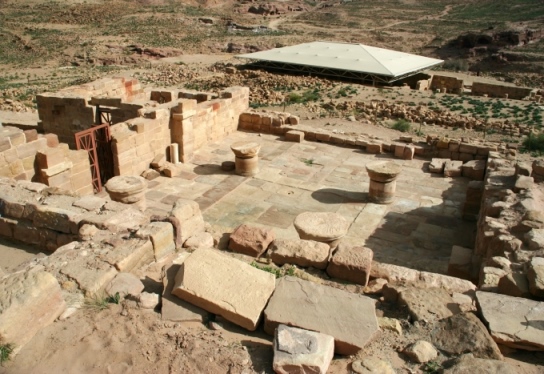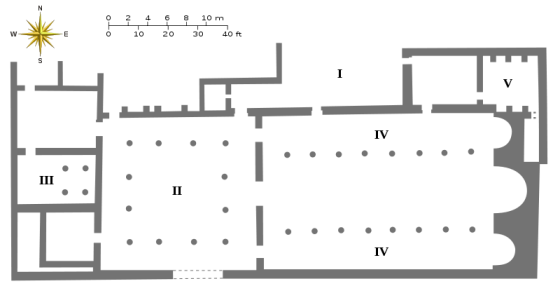

The Byzantine Church in Petra, also known as the Petra Church, is a significant archaeological site within the ancient city of Petra, Jordan, offering a window into the city’s Christian era during the 5th and 6th centuries CE. Discovered in 1990 by archaeologist Kenneth W. Russell and excavated primarily by the American Center of Oriental Research (ACOR) between 1992 and 2002, this church is a prime example of monumental Byzantine architecture and a testament to the thriving Christian community in Petra during late antiquity.
Petra, originally the capital of the Nabataean Kingdom, was a major
trading hub due to its strategic location along incense and spice trade
routes. After the Roman annexation in 106 CE, Petra became part of the
province of Arabia Petraea. By the 4th century CE, following Emperor
Constantine’s legalization of Christianity in 313 CE, Petra saw a
growing Christian presence, though it remained predominantly pagan. The
city came under Byzantine control in the 4th and 5th centuries, and
several churches were constructed, reflecting the spread of
Christianity.
The Byzantine Church, likely dedicated to the
Virgin Mary, was constructed in the second half of the 5th century CE
(around 450 CE) and served as a major cathedral, possibly the seat of
the bishop of Petra. The church was built over earlier Nabataean and
Roman structures, indicating a layering of cultural and religious
traditions. It remained in use until the early 7th century, when it was
destroyed by a fire, possibly exacerbated by earthquakes, and was
subsequently abandoned. The discovery of 152 carbonized papyrus scrolls
(known as the Petra Papyri) in 1993 provides invaluable insight into the
social, economic, and legal life of Petra’s inhabitants during the 6th
century, under Byzantine emperors Justinian, Justin II, and Tiberius II.
The church is part of a cluster of three Byzantine churches on a
hillside overlooking Petra’s city center, alongside the Ridge Church (or
Red Church, possibly the oldest, dating to the 3rd or 4th century) and
the Blue Chapel (named for its blue Egyptian granite columns). This
concentration of churches highlights the significance of Christianity in
Petra, even as the city’s economic importance declined after the 363 CE
earthquake and shifts in trade routes.

The Byzantine Church is a three-aisled basilica, measuring
approximately 26 meters by 15 meters (85 feet by 49 feet), with a
total area of about 400 square meters. Its layout and design are
characteristic of Byzantine ecclesiastical architecture, with
adaptations to the local environment and materials. Key
architectural features include:
Tripartite Basilica Layout:
The church consists of a central nave flanked by two smaller side
aisles, separated by rows of columns. The nave is paved with opus
sectile (cut stone) flooring, while the aisles are adorned with
intricate mosaics. Three apses (semicircular recesses) are located
at the eastern end, with the central apse likely housing the altar.
Three corresponding entrances (portals) at the western end provided
access to the church.
Construction Phases: Scholars distinguish
two main phases of construction:
Early Phase (c. 450 CE): The
original church had a single apse and an entrance porch. The Mosaic
of the Seasons in the southern aisle dates to this period.
Late
Phase (c. 500–550 CE): The church was remodeled to include two
additional side apses, a two-story atrium connecting the cathedral
to the baptismal complex, and additional mosaics in the northern
aisle and eastern end of the southern aisle. The nave was repaved,
and features such as chancel screens, a pulpit, and wall mosaics
were added.
Baptistery: A cruciform-shaped baptismal font,
surrounded by four columns that likely supported a dome, is located
in a side room. This baptistery underscores the church’s role in
religious ceremonies, including baptisms, which were central to
early Christian practice.
Atrium and Additional Structures: The
6th-century atrium linked the main church to the baptismal complex,
creating a unified religious complex. Side rooms, including a
storage room where the Petra Papyri were found, indicate the
church’s multifunctional role in community life.
Materials and
Hybridism: The church incorporates recycled materials from earlier
Nabataean and Roman structures, a common practice in Petra. The
architecture blends Nabataean rock-cut elements with Roman and
Hellenistic influences, reflecting a hybrid cultural identity. Local
sandstone was used for construction, and some columns and capitals
feature Nabataean horned designs.
Protective Shelter: Today, a
modern canopy covers the church to protect its delicate mosaics and
ruins from environmental damage, providing shade for visitors and
preserving the site’s integrity.
The Byzantine Church is renowned for its well-preserved figurative
floor mosaics, covering approximately 70 square meters in the side
aisles. These mosaics, created in the 5th and 6th centuries, are among
the finest in the region and reflect the artistic traditions of the
Byzantine world, with influences from the Gaza school and Hellenistic
and Roman iconography. Key features of the mosaics include:
Southern Aisle (Mosaic of the Seasons): The southern aisle is dominated
by personifications of the four seasons, identified by Greek
inscriptions. The mosaics are arranged in three columns within a
guilloche (interlaced) border:
The central column features human
figures, including the seasons and seven other figures identified by
Greek inscriptions, possibly representing virtues or deities.
The
outer columns depict animals, birds, and plants, symbolizing the
abundance of God’s creation.
Circular medallions, rectangular panels,
and conch-shaped designs add to the complexity of the composition.
Northern Aisle: The northern aisle features similar figurative mosaics,
including animals (real and mythical), human figures, and natural
motifs. These mosaics were added during the 6th-century remodeling and
are slightly more elaborate.
Iconography and Style: The mosaics
depict a wide range of subjects, including biblical scenes, early
Christian symbols, and personifications of the seasons, the ocean, the
earth, and wisdom. The vibrant colors and intricate designs reflect the
skill of the artisans and the church’s wealth. The style is comparable
to mosaics in Gaza and other Byzantine centers, situating Petra within a
broader artistic network.
Wall Mosaics: Fragments of wall mosaics
suggest that the church’s decoration extended beyond the floors, though
these are less well-preserved due to the fire and earthquakes.
The
mosaics are protected by the modern canopy and are a highlight for
visitors, offering a vivid glimpse into Byzantine artistry and theology.
Informational boards provide context, enhancing the visitor experience.
The Byzantine Church has yielded significant archaeological finds
that deepen our understanding of Petra’s Christian community and
Byzantine society:
Petra Papyri: In 1993, 152 carbonized papyrus
scrolls were discovered in a storage room, preserved by the fire that
destroyed the church. These 6th-century documents, written primarily in
Greek with Nabataean and Arabic terms, are the largest collection of
ancient written material found in Jordan. They include:
Property
contracts, tax records, out-of-court settlements, marriage agreements,
dowries, and inheritance documents.
A will dividing property
(including vineyards and slaves) among three brothers, likely part of
the family archive of Theodorus, an archdeacon of the church.
Records
spanning 528–582 CE, offering a snapshot of life in Petra during a
period of relative prosperity.
The papyri are still being deciphered
and are housed at the Jordan Museum in Amman, with publications (The
Petra Papyri, volumes I–V) detailing their contents.
Evidence of
Christian Life: The papyri and the church’s dedication to the Virgin
Mary confirm its role as a cathedral and the seat of the bishop. The
presence of Greek, Latin, and Nabataean names in the scrolls reflects
Petra’s multicultural population.
Construction and Destruction:
Excavations have revealed the church’s two-phase construction and its
destruction by fire and earthquakes. The carbonized scrolls and charred
remains of wooden elements (e.g., screens and furniture) provide clues
about the fire’s intensity.
Conservation Efforts: ACOR’s excavation
and restoration work, supported by USAID and the Jordanian Department of
Antiquities, has preserved the church and its mosaics. Ongoing
conservation ensures the site remains accessible to visitors.
The Byzantine Church is a key site for understanding the
Christianization of Petra and the broader Byzantine Middle East. Its
dedication to the Virgin Mary and its role as a cathedral highlight its
spiritual significance, making it a potential destination for Christian
pilgrims. The church’s mosaics and papyri reveal the wealth and cultural
sophistication of Petra’s Christian community, despite the city’s
declining economic status.
The church also reflects Petra’s
multicultural heritage, blending Nabataean, Roman, Hellenistic, and
Byzantine elements. This hybridism is evident in its architecture,
materials, and artistic styles, positioning Petra as a crossroads of
civilizations. The site’s location within the UNESCO World Heritage Site
of Petra enhances its global cultural value, attracting historians,
archaeologists, and tourists.
For visitors, the church offers a
serene and shaded retreat from Petra’s bustling main paths, with
panoramic views of the Colonnaded Street, Great Temple, and Royal Tombs.
Its spiritual ambiance, combined with its historical and artistic
richness, makes it a place for reflection and appreciation of Petra’s
layered history.
Location and Access: The church is located on a ridge overlooking
Petra’s city center, north of the Colonnaded Street and east of the
Temple of the Winged Lions. It is a 10-minute uphill walk from the
Colonnaded Street, accessible via the main trail through Petra’s
archaeological park. Visitors can reach Petra from Wadi Musa by car,
bus, or taxi, with parking available near the site entrance.
Visiting
Tips:
Visit early in the morning or late afternoon to avoid crowds
and heat. The canopy provides shade, but sturdy shoes, water, and sun
protection are essential due to uneven terrain and Petra’s desert
climate.
A local guide can provide deeper insights into the church’s
history and mosaics.
A small café near the church offers snacks, tea,
and restrooms.
Photography: The church’s mosaics and panoramic views
make it a popular spot for photography. The sheltered environment and
informational boards enhance the experience.
Guided Tours: Many tours
of Petra include the Byzantine Church alongside highlights like the
Treasury and Monastery. Multi-day tours from Amman, Eilat, or Tel Aviv
often cover the church as part of a broader Jordan itinerary.